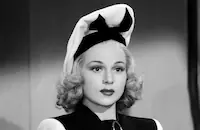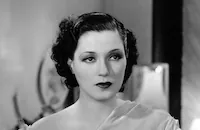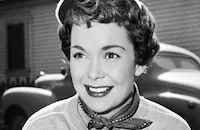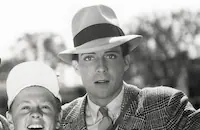Ready, Willing and Able

Brief Synopsis
Cast & Crew
Ray Enright
Ruby Keeler
Lee Dixon
Allen Jenkins
Louise Fazenda
Ross Alexander
Film Details
Technical Specs

Synopsis
Barry Granville and Pinky Blair, two would-be theatrical producers, get financing for their new musical on the condition that they hire Jane Clarke, a popular British actress, to star in it. In New York City, J. Van Courtland, a theatrical agent, learns of the project and rushes to meet the ship he believes Jane is taking to America. He mistakes an American girl, also named Jane Clarke, for the English actress and signs her to a contract. Jane, a college student who hopes to become an actress, impersonates the British actress in order to perform on Broadway and also because she has fallen in love with Barry. Although her dancing is fine, she cannot sing, and eventually confesses the truth to Barry, not realizing that the show's financing depends on the presence of the English Jane. Meanwhile, the English Jane is threatening to sue the company backing the production, and the company tries to break the contract. Barry reminds them that he has a contract to produce the show and will hold them to it. The company wants to produce the show themselves, however, and sends for the star, offering her more money than before. Pinky, Jane, her friend Angie and Van meet the boat and prevent Edward McNeil, the head of the company, from signing her. Even so, the actress refuses to sign with Barry until Van recognizes her as an American girl who used to have a seal act in vaudeville. She agrees to appear for Barry in return for Van's silence. Van also forces Barry to put Jane to work in the chorus. Still feeling badly for the trouble she caused Barry, Jane convinces Truman Hardy, her fiancé, to put up the money so the show can open. Barry, however, refuses to forgive Jane until Van tells him everything that she has done to help the show. Barry relents and tells Jane that he loves her.

Director
Ray Enright
Cast

Ruby Keeler
Lee Dixon

Allen Jenkins

Louise Fazenda

Ross Alexander

Carol Hughes

Hugh O'connell

Wini Shaw
Teddy Hart

Addison Richards
Shaw & Lee

E. E. Clive

Jane Wyman
May Boley

Charles Halton
Adrian Rosley
Lillian Kemble Cooper
Barnett Parker

Dickie Jones
Myrtle Stedman
Thomas Pogue
Milt Kibbee
Ferdinand Schumann-heink

George Andre Beranger
Bobby Watson
Hal Neiman
Al Herman

Dennis Moore
Carlyle Moore Jr.
Jeffrey Sayre
Saul Gorss
Gertrude Pedlar
William Worthington
Elsa Buchanan
Ferdinand Munier
Herbert Ashley
Harry Jackson
Helen Valkis
Cliff Saum
Billy Arnold
Jack Wise
Crew
Sam Bischoff
Bobby Connolly
Warren Duff
Pat C. Flick
Leo F. Forbstein
Doug Gould
Ray Heindorf
Sig Herzig
Lee Katz
Maurice Leo
Gene Lewis
Lew Lipton
Ben Markson
Mary Mccall Jr.
Johnny Mercer
Sol Polito
Howard Shoup
Jerry Wald
Jack L. Warner
Carl Jules Weyl
Richard Whiting

Film Details
Technical Specs

Award Nominations
Best Dance Direction
Articles
Ready, Willing and Able
Ruby Keeler's casting in Ready, Willing and Able as the young hopeful was somewhat ironic as it was to be her final film for Warner Bros. Keeler had dominated the studio's musical-comedies in the '30s with hits such as Footlight Parade (1933), Dames (1934) and Shipmates Forever (1935), all of them made with her perennial co-star Dick Powell. She would make only two more films after Ready, Willing and Able: Mother Carey's Chickens (1938), in a role Katharine Hepburn reportedly refused, and Sweetheart of the Campus (1941) opposite Ozzie Nelson.
The real newcomer in Ready, Willing and Able was Lee Dixon, who marked his first starring role in the film. Dixon had a short career, the highlights being The Singing Marine (1937) with Dick Powell and his turn as John Wayne's partner in Angel and the Badman (1947).
Dixon's co-star in Ready, Willing and Able, Ross Alexander, also had a short-lived movie career with a tragic ending. Alexander got his start on the New York stage before appearing in his first film The Wiser Sex (1932). He was soon signed by Warner Bros. and became a contract player. Many assumed Alexander was being groomed for stardom and he appeared in a number of A-pictures and prominent roles such as the Errol Flynn swashbuckler Captain Blood (1935) and as Demetrius in the star-studded A Midsummer Night's Dream (1935).
But in 1935, after four months of marriage, Alexander's first wife, stage actress Aleta Friele, shot and killed herself. Around the same time, Alexander's career took a downturn. He appeared in six pictures in 1936, but only one, China Clipper with Humphrey Bogart and Pat O'Brien, could be considered an A-picture. It seemed the studio had lost faith in him. In September 1936, Alexander married Anne Nagel, his costar in three pictures that year (including China Clipper plus Hot Money and Here Comes Carter). Then, on January 2, 1937, after only a few months of marriage, and close to the one year anniversary of his first wife's suicide, Alexander also took his own life. He was just 29-years old. Ready, Willing and Able would be his final film; it was released posthumously.
Ready, Willing and Able was nominated for one Oscar® for Bobby Connolly's choreography. Connolly, who had staged such Broadway productions as Ziegfeld Follies of 1931 and 1934, Funny Face and Good News, made his film debut as dance director on Moonlight and Pretzels (1933). Some of his most famous Hollywood credits include: dance director on Two Girls on Broadway (1940) and For Me and My Gal (1942); and the staging of musical numbers for The Wizard of Oz (1939).
One familiar face to watch for in Ready, Willing and Able is Jane Wyman. She's eleventh billed in the film as Dot, McNeil's Secretary. The film also features Warner Bros. regular Allen Jenkins. Best remembered for playing cabbies, gangsters and all manner of sidekicks, Jenkins made so many films during his contract run at Warners that he was sometimes referred to as "the fifth Warner Brother." Jenkins plays J. 'Katsy' Van Courtland in Ready, Willing and Able.
Producer: Samuel Bischoff, Hal B. Wallis, Jack L. Warner
Director: Ray Enright
Screenplay: Richard Macaulay, Jerry Wald, Sig Herzig, Warren Duff
Cinematography: Sol Polito
Film Editing: Doug Gould
Art Direction: Carl Jules Weyl
Music: Richard A. Whiting
Cast: Ruby Keeler (Jane Clarke), Lee Dixon (Pinky Blair), Allen Jenkins (J. Van Courtland), Louise Fazenda (Clara Heineman), Ross Alexander (Barry Granville), Carol Hughes (Angie).
BW-94m.
by Stephanie Thames

Ready, Willing and Able
Quotes
Trivia
Notes
Variety notes that this was Lee Dixon's first starring role. This was Ross Alexander's final film. He committed suicide in l937. According to Hollywood Reporter, Select Theatres filed suit against Warner Bros., alleging that the story "The Audition" which they copyrighted in 1925, had been plagerized in this film. The outcome of the suit has not been determined. Dance director Bobby Connolly received an Academy Award for his work on the "Too Marvelous for Words" number.















